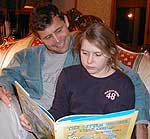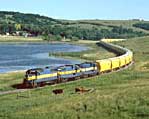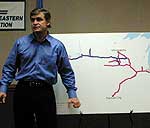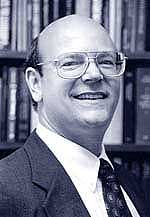By Cara Hetland
Minnesota Public Radio
March 11, 2002
|
|
RealAudio |
DM&E wants to lay 300 miles of new track from Wyoming's Powder River Basin to its existing line in western South Dakota. The access to the Powder River Basin's low sulfur coal is the key to DM&E's survival. The railroad will also upgrade 600 miles of existing track across South Dakota and Minnesota. DM&E's expansion is a bold plan that only one man can make happen.
| |
|
|
|
||
It's become a ritual in Kevin Schieffer's home. The DM&E president's daughter often reads to him from a book - a book that Schieffer says could just as easily be about his railroad.
"Then she said, 'I think I can, I think I can, I think I can,'" reads Brooke Schieffer, 12, from The Little Engine that Could. It's a book many people give Kevin Schieffer, almost as a joke. And, Schieffer keeps that light-hearted but determined attitude as he talks about the nation's largest railroad construction project.
"I'm working on a blueprint to get us in the ground next year," says Schieffer. "If that doesn't work it'll be the year after that. If that doesn't work, it'll be the year after that. We will get in the ground."
While Schieffer "thinks he can," many others wonder how. One of those is Jerry Ellig, deputy director of policy planning at the Federal Trade Commission. Ellig is surprised to see a project this big.
Ellig says over the last 20 years, the railroad industry has gotten smaller. There are fewer companies and they use less track. As a result, track is often abandoned and picked up by short line and regional railroads. Even the Dakota, Minnesota and Eastern Railroad was once an abandoned line.
| |
|
|
|
||
"I think after about 20 years of deregulated competitive railroads, there's a pretty strong understanding in Washington that railroads are here to stay. There may be a bit of traffic growth - not a lot of traffic growth - but there isn't a concern that railroads are going to disappear anymore, like we had 20 years ago. I don't know that anybody is looking for explosive growth either," Ellig says.
DM&E plans to buck that prediction. Company officials are counting on a growing coal market. Low sulfur coal is a hot commodity, as energy companies look for ways to increase utility production.
Ellig says it's unlikely any other regional railroad would ever propose a $1.5 billion expansion. But he says DM&E's close proximity to Wyoming's coal mines makes the expansion practical and realistic.
Twenty years ago, there were 40 large - or class one - railroads. Today there are just four. Right now, DM&E is a small regional railroad. Some say if the project is built, DM&E could threaten two of the nation's largest railroads, the Burlington Northern and Union Pacific, which currently haul the bulk of the coal out of Wyoming's Powder River Basin.
Economist Harvey Levine says the four large railroads dominate 95 percent of all freight traffic. He calls it a monopoly and thinks it has gone too far.
| |
|
|
|
||
"What the railroads claim is that they can't afford the competition because it's a high fixed-cost industry - with a lot of capital cost and overhead - and the more traffic they have the lower the unit cost. And the idea is to get more traffic by having less competition. But the industry has shrunk," says Levine.
But some Wall Street analysts are skeptical of DM&E's plans. None would be interviewed for this story. And many say DM&E is such a small regional carrier, it's not even on their radar. But some analysts have expressed their misgivings in written reports.
Morgan Stanley senior rail analyst James Valentine wrote that he doubts DM&E can attract customers or investors. Bear Stearns analyst Tom Wadewitz has written that competition is destructive to a railroad company's bottom line. When there is a choice, as in the Powder River Basin, company profit margins are at risk.
Last month, DM&E announced plans to buy a railroad that owns routes to Chicago and Kansas City. If approved, that deal would give DM&E a direct link to major cities, and thus the potential to draw in more customers. Without the new line, DM&E, like other regional railroads, would be forced to connect to Burlington Northern or Union Pacific to get products to market.
DM&E President Kevin Schieffer confesses he doesn't know where the money will come from for the project. Ultimately, investors will have to put down more than $1 billion for the expansion.
| |
|
|
|
||
"We are a tiny little railroad and we don't have two nickels to rub together - to be blunt about it. And that's part of what this project is about," says Schieffer. "If this project doesn't happen, this railroad will not be here long-term. And that, more than anything else, drives me."
Schieffer says his primary focus is to keep DM&E running. And in fact, finding investors for the expansion project is down on his list. First he needs the money to buy the regional rail link. Then, he says, he'll have an attractive package to present to funders for the Powder River Basin expansion.
"When the time comes, if you have a package that makes sense, it will happen. And I'm focused on putting together a package that makes sense. If we can accomplish that, it will be financed," says Schieffer. "I can't write a $1.5 billion check. So, I need to make sure when we go to someone and ask them to write a $1.5 billion check, that they will have confidence in doing that."
Schieffer says the plan will make sense to investors - because he says there's a need for low sulfur coal, and for a more reliable rail transportation system.
But the benefits aren't just about coal and electricity. Schieffer says the railroad expansion will create economic development and new jobs. It will also help farmers get their crops to market. Schieffer believes because of that, the financing will come together. Then the Dakota, Minnesota and Eastern Railroad will be able to take on what some call this country's railroad monopoly.
More from MPR



